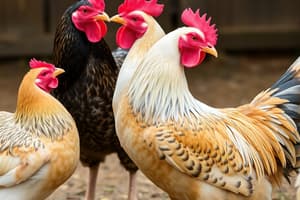Podcast
Questions and Answers
What are some common problems experienced by animals living in zoos?
What are some common problems experienced by animals living in zoos?
- Stereotypical behaviors, genetic problems, and physical injuries
- Apathy, sadness, boredom, and eating disorders
- All of the above (correct)
- Self-mutilation, abnormal sexual behaviors, and maternal behaviors
Why do animals in zoos develop stereotypic behaviors?
Why do animals in zoos develop stereotypic behaviors?
- Due to the lack of social interaction with humans
- Due to a lack of space and resources
- Because of the stress of captivity and inability to live according to their natural instincts (correct)
- As a result of poor breeding programs
What is one of the conservation efforts made by zoos?
What is one of the conservation efforts made by zoos?
- Providing education to visitors
- Breeding endangered species (correct)
- Reintroducing animals back into the wild
- Conducting research on animal behavior
What is a concern raised by critics about keeping animals in zoos?
What is a concern raised by critics about keeping animals in zoos?
What do some zoos try to achieve for their animals?
What do some zoos try to achieve for their animals?
What can be a limitation of zoos?
What can be a limitation of zoos?
What can studying animals in zoos help with?
What can studying animals in zoos help with?
What is a consequence of animals living in unnatural environments in zoos?
What is a consequence of animals living in unnatural environments in zoos?
Flashcards are hidden until you start studying
Study Notes
Zoos and Animal Welfare
- Animals in zoos are kept in captivity, suppressing their natural instincts, leading to genetic, physical, and behavioral problems.
- These problems include stereotypical behaviors, apathy, sadness, boredom, eating disorders, self-mutilation, and abnormal sexual or maternal behaviors.
- The stress of captivity and inability to live according to their natural instincts cause these problems.
Limitations of Zoos
- Some zoos have insufficient space or unsuitable enclosures, leading to health conditions and behavioral problems.
- Animals in these zoos may develop stereotypic behaviors, repeating the same movements over and over.
Importance of Zoos
- Studying animals in zoos can help improve the lives of their counterparts in nature.
- Zoos contribute to conservation efforts by breeding endangered species and reintroducing them into the wild.
Concerns About Zoos
- Not all zoos have the resources to properly care for their animals.
- Animals in zoos may have limited space, live in unnatural environments, and be kept in crowded conditions.
- Keeping animals captive can be harmful to their physical and psychological health.
Ensuring Animal Welfare
- It is important to consider both the advantages and disadvantages of zoos.
- Ensuring that animals in zoos have their complex needs met and are not subjected to harmful conditions is crucial.
- Understanding the pros and cons of zoos can help create better environments for animals in captivity.
Studying That Suits You
Use AI to generate personalized quizzes and flashcards to suit your learning preferences.




